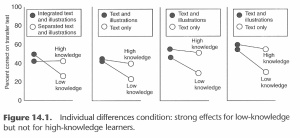On the way to Rochester on Monday (across two planes, 3 hour delay, and 2 hour flight), I read Richard E. Mayer’s Multimedia Learning, 2nd Edition which I highly recommend. It’s a synopsis of literally dozens of studies, categorized as supporting (and sometimes disputing) 12 principles of how to design multimedia for effective and transferable learning. I saw a lot of great ideas for how to improve computing education. That observation also has a downside. Some of Mayer’s well-supported principles aren’t appearing anywhere in computing education that I can see.
One figure really struck me, and I’m including it here (hoping that a single figure counts as ‘fair use’):
This figure summarizes four studies where student data were split based on the amount of prior knowledge that students had about the field of study. In one experiment, the experimental treatments were integrating text and pictures (text next to pictures) and the other where they were separated. In the other three experiments, students were shown text with supporting illustrations vs. only text.
What’s striking about these four results is the huge difference for students with low knowledge. Doing it right matters a lot for these students. What’s also striking is how it doesn’t make much difference for the high knowledge students. In fact, in the first experiment, the low-knowledge students even did better than the high knowledge students when given integrated text plus illustrations.
I don't actually have a point about learning styles, except to say that indeed, the hackneyed version that trickles down through professional development lectures to mandated lesson plan requirements is indeed hackneyed. But the truth is out there, and it is subtle and complex.
Also, I look forward to Dan's review of this book.

1 comment:
Dr. Mayer's book is definitely an excellent book for anyone interested in multimedia... a couple of my thoughts:
1. The research in this book is mostly about multimedia presentations (i.e. the learner watching something on the screen that tells them how something works).
2. The test that the picture refers to is a "transfer test", ie a measure of how well the learner transfered the information from the presentation to another context.
3. The fact that low-knowledge learners performed better after watching multimedia... while high-knowledge learners did not see much of a difference... is really interesting! At the very least these charts tells me:
A. Multimedia presentations (i.e. videos on Youtube) that are well designed can help novices in a subject gain information fairly quickly.
B. People who already know something about the subject aren't helped as much because... wait for it... they probably already know the information. Once one knows the information, it seems like we need to learn something else in order to know how to "transfer" the knowledge to other applications...
quite interesting!
Post a Comment